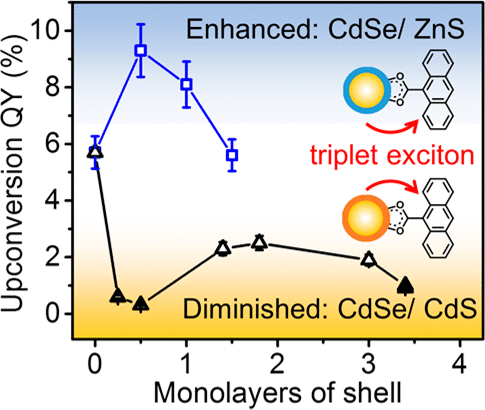当前位置:
X-MOL 学术
›
ACS Photonics
›
论文详情
Our official English website, www.x-mol.net, welcomes your
feedback! (Note: you will need to create a separate account there.)
ZnS Shells Enhance Triplet Energy Transfer from CdSe Nanocrystals for Photon Upconversion
ACS Photonics ( IF 6.5 ) Pub Date : 2018-06-20 00:00:00 , DOI: 10.1021/acsphotonics.8b00338 Zhiyuan Huang 1 , Pan Xia 2 , Narek Megerdich 3 , Dmitry A. Fishman 4 , Valentine I. Vullev 1, 5 , Ming Lee Tang 1, 2
ACS Photonics ( IF 6.5 ) Pub Date : 2018-06-20 00:00:00 , DOI: 10.1021/acsphotonics.8b00338 Zhiyuan Huang 1 , Pan Xia 2 , Narek Megerdich 3 , Dmitry A. Fishman 4 , Valentine I. Vullev 1, 5 , Ming Lee Tang 1, 2
Affiliation

|
Triplet energy transfer (TET) from semiconductor nanocrystals (NCs) to molecules is one of the bottlenecks that limits the efficiency of photon upconversion. While an inorganic shell can enhance the photoluminescence quantum yields (PLQYs), the role of the shell with respect to TET is still not clear. In this work, CdS and ZnS shells with different shell thickness are grown on 2.9 nm diameter CdSe NCs, resulting in nanostructures here that have increased radiative rates compared to the core. TET from these NCs to bound 9-anthracene carboxylic acid is investigated with linear photon upconversion measurements, time-resolved photoluminescence lifetime, and transient absorption spectroscopy. The ZnS shell enhances the photon upconversion QYs 1.6 times from 5.7% to 9.3%, with a concurrent increase of TET efficiency from 6.68% to 12.9% and the net rate of TET from 4.97 × 108 s–1 to 6.67 × 1010 s–1. In contrast, TET is barely observed for CdSe/CdS core–shell NCs. Considering the changes in PLQYs and upconversion QYs, a sub-monolayer ZnS shell enhances TET by removing surface traps and increasing exciton lifetime, while a thick shell creates an energy barrier that diminishes TET. The shorter exciton lifetime and increased exciton–phonon coupling due to CdS explain the drastically different effects of ZnS and CdS shells.
中文翻译:

ZnS壳增强了CdSe纳米晶体的三重态能量转移,从而实现了光子上转换。
从半导体纳米晶体(NC)到分子的三重态能量转移(TET)是限制光子上转换效率的瓶颈之一。尽管无机壳可以提高光致发光量子产率(PLQYs),但壳对TET的作用仍不清楚。在这项工作中,具有不同壳厚度的CdS和ZnS壳在直径为2.9 nm的CdSe NCs上生长,从而形成纳米结构,与核相比,其辐射速率增加。通过线性光子上转换测量,时间分辨的光致发光寿命和瞬态吸收光谱研究了这些NCs与结合的9-蒽羧酸的TET。ZnS壳层将光子上转换QY从5.7%提高到9.3%1.6倍,同时TET效率从6.68%提高到12。8 s –1至6.67×10 10 s –1。相反,对于CdSe / CdS核-壳型NC,几乎未观察到TET。考虑到PLQY和上转换QY的变化,亚单层ZnS壳通过消除表面陷阱和增加激子寿命来增强TET,而厚壳则形成了减小TET的能垒。由于CdS,激子寿命更短,激子与声子的耦合增加,这说明ZnS和CdS壳层的作用截然不同。
更新日期:2018-06-20
中文翻译:

ZnS壳增强了CdSe纳米晶体的三重态能量转移,从而实现了光子上转换。
从半导体纳米晶体(NC)到分子的三重态能量转移(TET)是限制光子上转换效率的瓶颈之一。尽管无机壳可以提高光致发光量子产率(PLQYs),但壳对TET的作用仍不清楚。在这项工作中,具有不同壳厚度的CdS和ZnS壳在直径为2.9 nm的CdSe NCs上生长,从而形成纳米结构,与核相比,其辐射速率增加。通过线性光子上转换测量,时间分辨的光致发光寿命和瞬态吸收光谱研究了这些NCs与结合的9-蒽羧酸的TET。ZnS壳层将光子上转换QY从5.7%提高到9.3%1.6倍,同时TET效率从6.68%提高到12。8 s –1至6.67×10 10 s –1。相反,对于CdSe / CdS核-壳型NC,几乎未观察到TET。考虑到PLQY和上转换QY的变化,亚单层ZnS壳通过消除表面陷阱和增加激子寿命来增强TET,而厚壳则形成了减小TET的能垒。由于CdS,激子寿命更短,激子与声子的耦合增加,这说明ZnS和CdS壳层的作用截然不同。











































 京公网安备 11010802027423号
京公网安备 11010802027423号